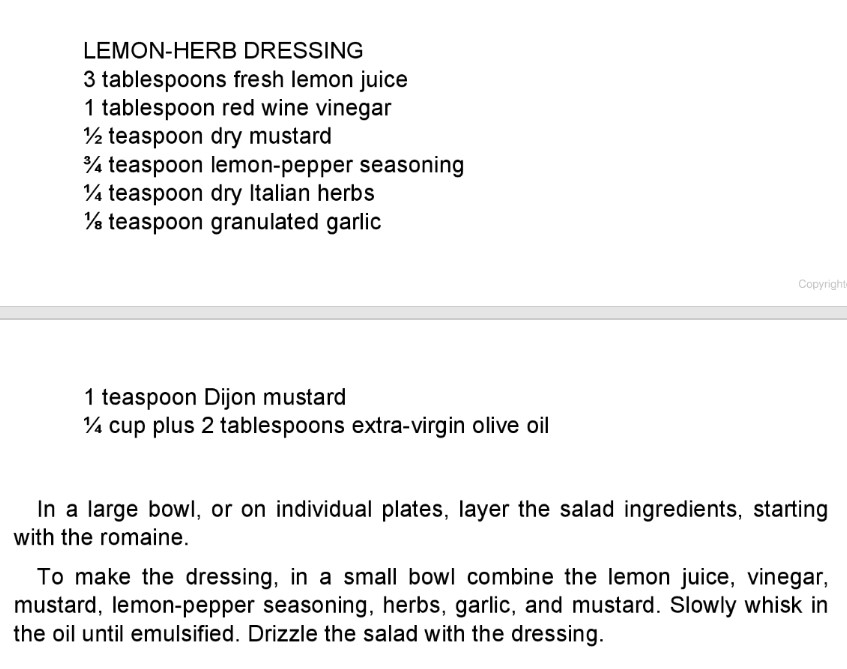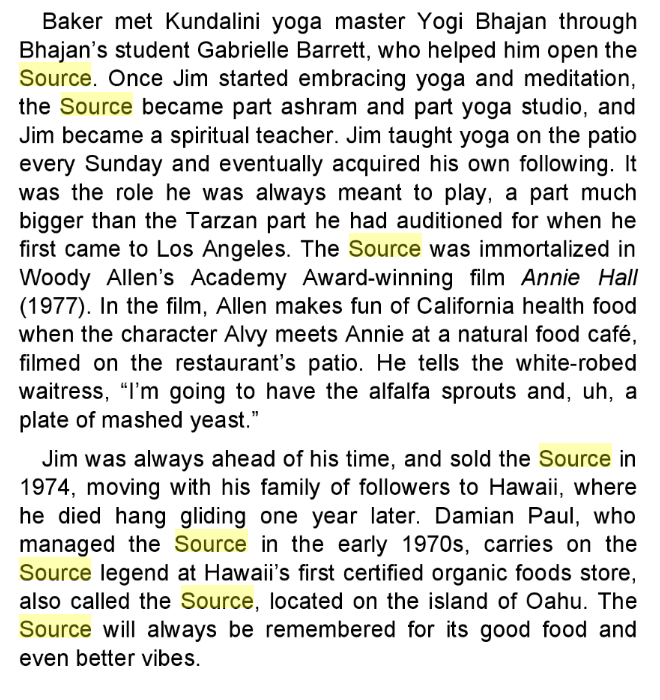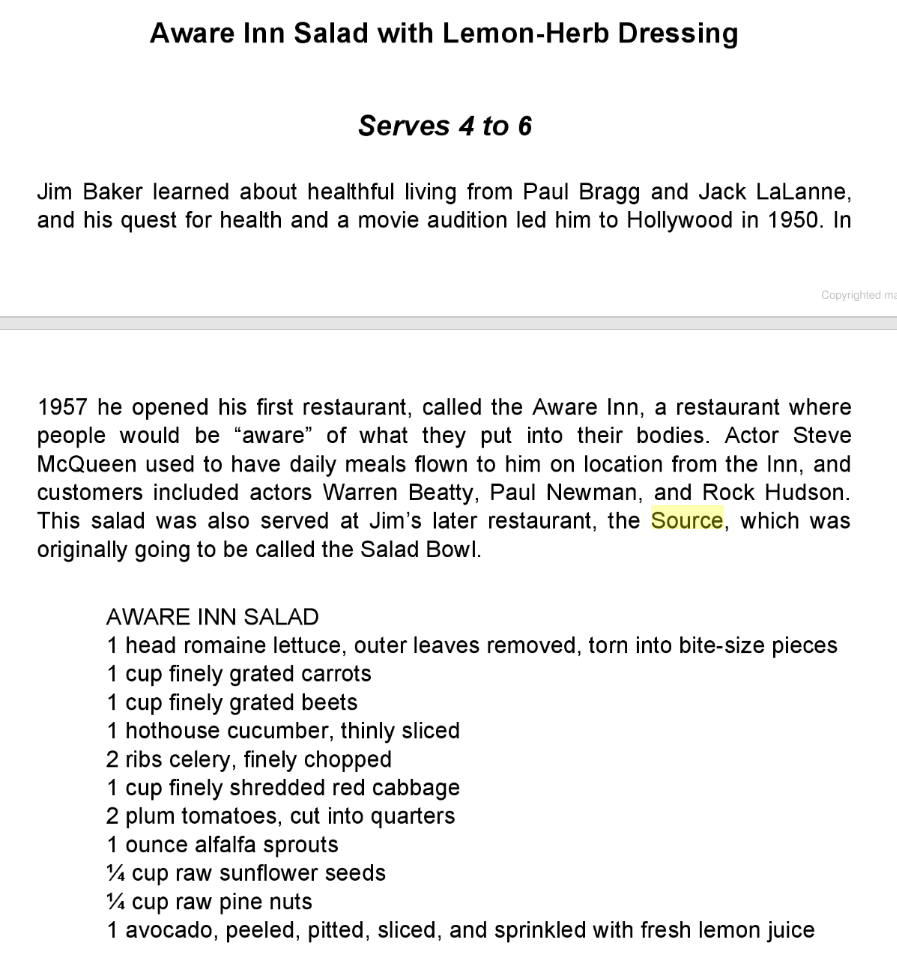So last night I was watching The Source Family, about the cult of the same name that existed in Los Angeles in the 1970s. The founder of the source family, Jim Baker, became a health food nut after being introduced to Paul Bragg, who founded Brag Apple Cider vinegar, and became one of the first health food and supplement nuts in the 1960’s in California. Baker then got into Kundalini yoga and some other new age movements, propelling his popularity among the young hipsters that congregated around him.
The cult got its real start as something mainstream which attracted quite the following, with the opening of the Source Restaurant, a vegetarian restaurant that was on the frontier of “hippie cafes” and health food restaurants. It was frequented by lots of celebrities and it’s the place where Woody Allen sarcastically orders “a plate of mashed yeast” in Annie Hall. n 1969, Baker founded the Source Restaurant on Los Angeles’s Sunset Strip. The restaurant served organic vegetarian food, with such celebrity regulars as John Lennon, Julie Christie and Marlon Brando. Jim Baker had two other successful restaurants on Sunset Strip: the Aware Inn and the Old World. In the beginning of the documentary when they’re still talking mostly about the restaurant itself and not much about the cult yet, several people are quoted as saying that Source had “the most incredible” salad dressing.
The Source Family is a documentary film which recounts the story of James Edward Baker who dubbed himself Father Yod, later YaHoWa, and the Source Family. Much of the material was gleaned from Isis Aquarian’s archives of photos, diary, film, cassette tapes of Father Yod’s morning class, lost music tapes, graphics; along with input interviews of Source family members and people who knew Jim Baker and/or went to the Source Restaurant. Since the 1960’s, there has been an increasing openness to metaphysical and occult ideas in the United States. This New Age philosophy is becoming the religion, of the modern day and we have to be near the epicenter of these movements in Colorado. The New York Times Magazine said, “The New Age Movement is a protean phenomenon that embraces cults like the Church of Scientology and the Unification Church, nominally secular self-improvement programs like Lifespring and est, and a myriad of ”teachers” who blend psychotherapeutic techniques with Eastern mysticism, the occult, the ”healing power” of pyramids and quartz crystals, pre-Christian paganism or witchcraft and other forms of spiritualism. Increasingly, it also includes a significant constituency that has absorbed ”transformational” values through some form of personal therapy, professional training courses or even public education. What virtually all participants in the New Age movement have in common is the belief in a cosmic destiny for mankind, which individuals pursue mainly through mystical examination of the self; and in a ”new age” of existence that will be peopled by superior beings who have undergone a process of inner ”transformation.””
I have to admit I have some kind of fascination with cults, perhaps because I find it fascinating how people can get sucked into them. Most of the leaders are so charming, you can understand why people want to follow them, other than perhaps, other than maybe David Koresh of the Branch Davidians who wasn’t particularly charming but who did make you fear the end of time, especially if it is to be spent with him. Or maybe it is because we have one here very nearby us, that has been ridiculed for years, and yet the creator of this cult had read over 40,000 books on the occult and had them in his library, so he was clearly a clever dude; anyway, and I haven’t been this enthralled with a documentary since Wild Wild Country which depicts Bhagwan Shree Rajneesh, his lieutenant Sheela Birnstiel (aka Ma Anand Sheela) and a few thousand members of the Rajneesh community bought a 100-square-mile ranch in Antelope, Oregon, with a goal to establish Rajneeshpuram — a self-sustaining utopian community — but that dream devolved amidst clashing egos. Anyway, I wasn’t about to copy their recipes, which included Haldol-laced beer, but the Source’s salad dressing recipe seemed interesting and non-hallucinogenic. By the way, Osho’s books are definitely worth a read, he was on to something, and his best compilation is in the Orange Book. Anyway, the Source Family still exists to some degree on the North Shore of Oahu, we met some of those folks the last time we were there— some turned to Life Spring, The Fourth Way, and Advaita after Baker’s death. Others went on to found very successful businesses like Bragg Apple Cider Vinegar (sold at Source Foods on the North Shore of Oahu as well as nearly every other store in the world nowadays which also sells DMSO for humans), software companies, and many other ventures.
In Hippie Food: How Back-to-the-Landers, Longhairs, and Revolutionaries Changed the Way We Eat by Jonathan Kauffman discusses The Source restaurant. Kauffman says, “The restaurant’s best seller, the Source Special, is the one all the family members remember with fondness and longing, because none of them thought to retain the recipe for its key ingredient, Source Dressing, which Rosa Cardini’s company continued to manufacture for Baker. They’d spread the lemon-herb vinaigrette onto a slice of whole-wheat bread, then layer on a thick green smear of guacamole, sliced raw mushrooms, tomatoes, and a pouf of alfalfa sprouts. Onto the top would go a few slices of Cheddar cheese, then it’d be slipped under the broiler until the cheese melted.” Several other Source recipes are found here.
Here is the Source Lemon Herb Dressing Recipe from Cardini’s daughter below. As an interesting aside, it might be tempting to assume that the Caesar salad owes its name to the renowned Roman statesman, Julius Caesar; however, this iconic appetizer is unrelated to the historical figure. Instead, the salad is credited to Caesar Cardini, an Italian American restaurateur and chef. In 1919, one year before the Prohibition era began, Cardini inaugurated his first restaurant in California. In the 1920s, seeking the ability to legally serve alcohol, he expanded across the border and established a new eatery named Caesar’s in Tijuana, Mexico. It was at this locale that the famous Caesar salad recipe was concocted. While debates persist about its exact origin, Caesar Cardini unequivocally asserted ownership of the creation and promoted the salad under his name.
According to Rosa Cardini, the daughter of Caesar Cardini, the inaugural Caesar salad was improvised during a bustling Fourth of July weekend in 1924. Allegedly, running out of other ingredients, Cardini assembled whatever was on hand—romaine lettuce, olive oil, egg, croutons, Worcestershire sauce, and Parmesan—and directed his chefs to mix it at the table for an added element of spectacle. Other accounts propose that the salad was devised by Cardini’s brother, Alessandro, aiming to impress a group of airmen dining at Caesar’s. Alternatively, some argue that the credit goes to a restaurant employee named Livio Santini, who supposedly based the salad on his mother’s recipe. Regardless of the differing narratives, Caesar Cardini returned to Los Angeles and, in 1938, established a shop to sell bottles of his widely popular salad dressing bearing his name.
Here is Rosa Cardini’s Source Salad Dressing Recipe:
Another Recipe from the Source Restaurant-Mushroom Barley Soup
Ingredients:
2 cups barley
1 onion diced
1⁄2 cup celery diced
2 pounds sliced mushrooms
1 tablespoon butter
2 tablespoons olive oil
3 cloves crushed garlic
1⁄2 cup sour cream
Salt and pepper to taste
Directions:
Lightly sauté celery, onion and mushrooms with olive oil, butter and garlic, then add to barley in large soup pot with 12 cups water, cook over medium heat until barley is soft, remove from heat and stir in sour cream.
CAESAR SALAD FROM CARDINI’S FATHER
The Caesar Salad is named after it’s inventor Caesar Cardini, not Julius Caesar or Caesar Augustus, originally prepared tableside by Caesar himself in his restaurant in Tijuana, Mexico, in the 1920s-1940s. Contrary to popular belief, the original Caesar’s salad recipe (unlike his brother Alex’s Aviator’s salad) did not contain anchovy; the slight whisper of anchovy flavor comes from the Worcestershire sauce. Cardini was opposed to using anchovies in his salad.
Cardini was not inclined to vary his recipe. In a 1987 interview with the Honolulu Star-Bulletin, his daughter Rosa Cardini said her father was very precise in preparing his creation. He used only the tender, inner leaves of Romaine lettuce and left them whole, intending diners to pick them up with their fingers. He boiled the eggs for one minute before adding them, and he didn’t use anchovies.
There is some debate about the origins of the salad. Some claim the recipe was actually from the mother of Livio Santini, one of Cardini’s chefs and a fellow Italian immigrant. Others say Cardini’s brother Alex was the originator of the salad, which he made with limes and anchovy paste. Alex’s version was dubbed “Aviator’s Salad” because he supposedly served it to airmen from a San Diego base.
Forrest said the recipe also echoes old Italian specialties. It resembles a pinzimonio, a dressing of olive oil and lemon juice used as a vegetable dip, or a bagna cauda, a hot dip of anchovy and garlic from the Piedmont region where Cardini was born.
INGREDIENTS YOU’LL NEED
CROUTONS:
2 cups of Day Old Italian bread cubed to 1/2 inch
Dry in a 325 degree oven (do not let them brown)
GARLIC OIL:
Pulverize 3 cloves of Garlic with
1/4 tsp kosher salt
1/4 cup Extra Virgin olive oil
CODDLE EGGS:
Bring 2 cups of water to a boil
Prepare a bowl with water & ice
PREPARE BEFORE TOSSING:
1 Very large Bowl
2 Salad Tossers (one for each hand)
1 1/2 lemons – Halved with the seeds removed
Kosher salt
1/4 cup plus 2 TB Extra Virgin Olive oil
9 Dashes of Worcestershire
10 Grinds of Black Pepper
1 1/2 oz of Parmagiano-Reggiano (not ‘Parmesan’, and PLEASE not the ‘Green Can’ that I grew up on)
2 heads of Romaine lettuce outer leaves removed (16oz); Core removed, Leaves separated, washed and dried (This allows the oil to adhere to the leaves) You can tear the leaves into smaller, more manageable pieces if desired. Keep well chilled until ready to toss.
DIRECTIONS
CROUTONS:
Strain oil into a skillet over medium heat and fry the dried croutons, tossing until all oil is absorbed and the croutons turn golden brown. Set them aside (Try not to eat them while performing the next steps, I know it’s hard to resist warm croutons)
CODDLED EGGS:
Immerse 2 eggs in boiling water for 1 minute and 1 minute ONLY
Remove and immediately place in ice bath to stop cooking.
ARCHITECTING THE SALAD:
Place romaine in bowl and toss with 3 TB of the Olive oil, just enough to lightly coat the leaves.
Sprinkle with a pinch of kosher salt and 10 grinds black pepper and remaining 3TB olive oil and toss well.
Use a kind of rolling motion to move the leaves around, this minimizes bruising.
Squeeze the lemon juice over the leaves as well as the Worcestershire and toss again, briefly.
Crack coddled eggs over leaves and toss until the eggs create an emulsion of lemon juice and olive oil.
Your ingredients will achieve a creamy consistency, kind of very pale beige.
Grate the Parmigiano-Reggiano over and toss to incorporate.














